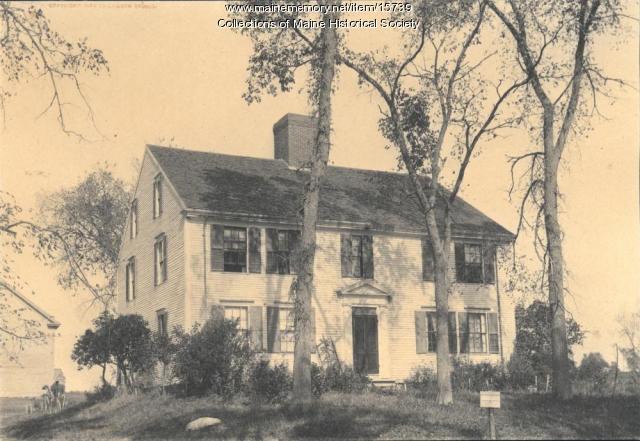Keywords: Associates
Item 22989
Tennessee Valley Associates butter churn, Mapleton, ca. 1935
Contributed by: Haystack Historical Society Date: circa 1935 Location: Mapleton Media: Glass, metal
Item 76037
Maine Camp Hospital Association records, Portland, 1862
Contributed by: Maine Historical Society Date: 1862 Location: Portland Media: Ink on paper
Item 32208
217-224 Anderson Street Extension, Portland, 1924
Owner in 1924: Pinkham Associates, Inc. Style: Utilitarian Use: Factory
Item 85621
Great Diamond Island Association property, Great Diamond Island, Portland, 1924
Owner in 1924: Great Diamond Island Association Use: Wharf & Waiting Room
Item 150257
Development Associates Trust building, Bangor, 1967-1979
Contributed by: Maine Historical Society Date: 1967–1979 Location: Bangor Client: Development Associates Trust Architect: Eaton W. Tarbell
Item 150093
Eaton W. Tarbell and Associates office alterations, Bangor, 1945-1948
Contributed by: Maine Historical Society Date: 1945–1948 Location: Bangor Client: Eaton W. Tarbell and Associates Architect: Eaton W. Tarbell
Exhibit
A Celebration of Skilled Artisans
The Maine Charitable Mechanic Association, an organization formed to promote and support skilled craftsmen, celebrated civic pride and members' trades with a parade through Portland on Oct. 8, 1841 at which they displayed 17 painted linen banners with graphic and textual representations of the artisans' skills.
Exhibit
While numerous Mainers worked for and against woman suffrage in the state in the late nineteenth and early twentieth centuries, some also worked on the national level, seeking a federal amendment to allow women the right to vote
Site Page
View collections, facts, and contact information for this Contributing Partner.
Site Page
West Quoddy Head Light Keepers Association
View collections, facts, and contact information for this Contributing Partner.
Story
BLUEGRASS MUSIC ASSOCIATION OF MAINE
by BLUEGRASS MUSIC ASSOCIATION OF MAINE
A story about the Bluegrass Music Association of Maine
Story
Somali Bantu farmers put down roots in Maine
by Muhidin D. Libah
Running the Somali Bantu Community Association and finding food security in Maine
Lesson Plan
Longfellow Studies: Henry Wadsworth Longfellow & Harriet Beecher Stowe
Grade Level: 9-12
Content Area: Social Studies
As a graduate of Bowdoin College and a longtime resident of Brunswick, I have a distinct interest in Longfellow. Yet the history of Brunswick includes other famous writers as well, including Harriet Beecher Stowe. Although they did not reside in Brunswick contemporaneously, and Longfellow was already world-renowned before Stowe began her literary career, did these two notables have any interaction? More particularly, did Longfellow have any opinion of Stowe's work? If so, what was it?
Lesson Plan
Longfellow Studies: "The Jewish Cemetery at Newport"
Grade Level: 6-8, 9-12
Content Area: English Language Arts, Social Studies
Longfellow's poem "The Jewish Cemetery at Newport" opens up the issue of the earliest history of the Jews in America, and the significant roles they played as businessmen and later benefactors to the greater community. The history of the building itself is notable in terms of early American architecture, its having been designed, apparently gratis, by the most noted architect of the day. Furthermore, the poem traces the history of Newport as kind of a microcosm of New England commercial cities before the industrialization boom. For almost any age student the poem could be used to open up interest in local cemeteries, which are almost always a wealth of curiousities and history. Longfellow and his friends enjoyed exploring cemeteries, and today our little local cemeteries can be used to teach little local histories and parts of the big picture as well.
Henry Wadsworth Longfellow visited the Jewish cemetery in Newport, RI on July 9, 1852. His popular poem about the site, published two years later, was certainly a sympathetic portrayal of the place and its people. In addition to Victorian romantic musings about the "Hebrews in their graves," Longfellow includes in this poem references to the historic persecution of the Jews, as well as very specific references to their religious practices.
Since the cemetery and the nearby synagogue were restored and protected with an infusion of funding just a couple years after Longfellow's visit, and later a congregation again assembled, his gloomy predictions about the place proved false (never mind the conclusion of the poem, "And the dead nations never rise again!"). Nevertheless, it is a fascinating poem, and an interesting window into the history of the nation's oldest extant synagogue.





















